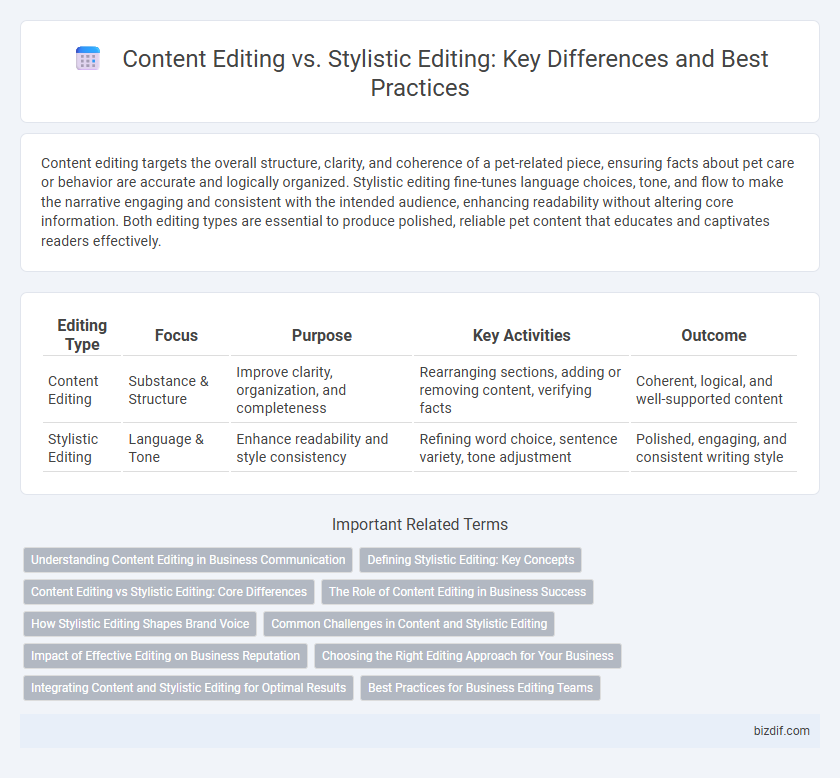Content editing targets the overall structure, clarity, and coherence of a pet-related piece, ensuring facts about pet care or behavior are accurate and logically organized. Stylistic editing fine-tunes language choices, tone, and flow to make the narrative engaging and consistent with the intended audience, enhancing readability without altering core information. Both editing types are essential to produce polished, reliable pet content that educates and captivates readers effectively.
Table of Comparison
| Editing Type | Focus | Purpose | Key Activities | Outcome |
|---|---|---|---|---|
| Content Editing | Substance & Structure | Improve clarity, organization, and completeness | Rearranging sections, adding or removing content, verifying facts | Coherent, logical, and well-supported content |
| Stylistic Editing | Language & Tone | Enhance readability and style consistency | Refining word choice, sentence variety, tone adjustment | Polished, engaging, and consistent writing style |
Understanding Content Editing in Business Communication
Content editing in business communication involves reviewing and revising the core message to ensure clarity, coherence, and purpose alignment with organizational goals. It prioritizes factual accuracy, logical flow, and relevance to the target audience, enabling effective decision-making and stakeholder engagement. This type of editing enhances the substantive value of documents like reports, proposals, and presentations, ensuring they convey the intended meaning convincingly.
Defining Stylistic Editing: Key Concepts
Stylistic editing focuses on enhancing the voice, tone, and flow of a text to improve readability and engagement while maintaining the author's original intent and style. Key concepts include consistency in word choice, sentence structure, and pacing, ensuring the text resonates with the target audience. Unlike content editing, which prioritizes factual accuracy and organization, stylistic editing refines the emotional impact and clarity of the writing.
Content Editing vs Stylistic Editing: Core Differences
Content editing focuses on the substance and structure of the text, ensuring clarity, coherence, and logical flow of ideas to enhance the overall message. Stylistic editing targets the tone, language style, and readability, refining word choice, sentence variety, and voice to align with the intended audience. Core differences lie in content editing's emphasis on organization and accuracy versus stylistic editing's focus on expression and engagement.
The Role of Content Editing in Business Success
Content editing plays a crucial role in business success by ensuring that messages are clear, accurate, and aligned with brand goals, effectively engaging target audiences. It involves evaluating the structure, logic, and factual accuracy of materials, which enhances credibility and drives customer trust. Prioritizing content editing helps businesses create persuasive communication that supports marketing strategies and boosts overall performance.
How Stylistic Editing Shapes Brand Voice
Stylistic editing refines tone, word choice, and sentence structure to consistently convey a brand's personality and values across all content. By emphasizing language style and voice, it transforms raw text into a cohesive message that resonates with target audiences and strengthens brand identity. This tailored approach distinguishes brands in competitive markets through clear, engaging, and memorable communication.
Common Challenges in Content and Stylistic Editing
Content editing often faces challenges like maintaining factual accuracy while ensuring logical flow, clarity, and coherence throughout the text. Stylistic editing struggles commonly involve preserving the author's voice and tone while enhancing readability and adhering to style guides and genre conventions. Both types of editing require balancing precision with creativity to produce polished, engaging content that meets the intended audience's expectations.
Impact of Effective Editing on Business Reputation
Effective content editing ensures clarity, accuracy, and relevance, directly enhancing customer trust and engagement, which strengthens a business's reputation. Stylistic editing improves readability and tone, aligning content with brand voice to foster a consistent and professional image. Together, these editing forms elevate brand credibility, drive customer loyalty, and contribute to long-term business success.
Choosing the Right Editing Approach for Your Business
Content editing hones in on the accuracy, clarity, and structure of your business's message, ensuring it aligns with your target audience and goals. Stylistic editing refines tone, flow, and language consistency to elevate brand voice and reader engagement. Selecting the right editing approach depends on whether your priority lies in correcting factual content and organization or enhancing narrative style and readability for your professional communications.
Integrating Content and Stylistic Editing for Optimal Results
Integrating content editing and stylistic editing ensures a comprehensive refinement of written material by addressing both the clarity of ideas and the flow of language. Content editing focuses on structure, coherence, and logical consistency, while stylistic editing enhances tone, word choice, and readability tailored to the target audience. Combining these processes optimizes overall quality, delivering polished, engaging, and impactful text that effectively communicates its intended message.
Best Practices for Business Editing Teams
Content editing prioritizes clarity, accuracy, and logical flow to ensure core messages align with business goals and brand voice, while stylistic editing refines tone, word choice, and sentence structure to enhance reader engagement and consistency. Best practices for business editing teams include establishing clear guidelines for both editing types, leveraging collaborative tools to streamline feedback, and maintaining a consistent style guide that reflects the company's identity. Regular training sessions focusing on these distinctions improve overall document quality and effectiveness in communication.
Content Editing vs Stylistic Editing Infographic

 bizdif.com
bizdif.com